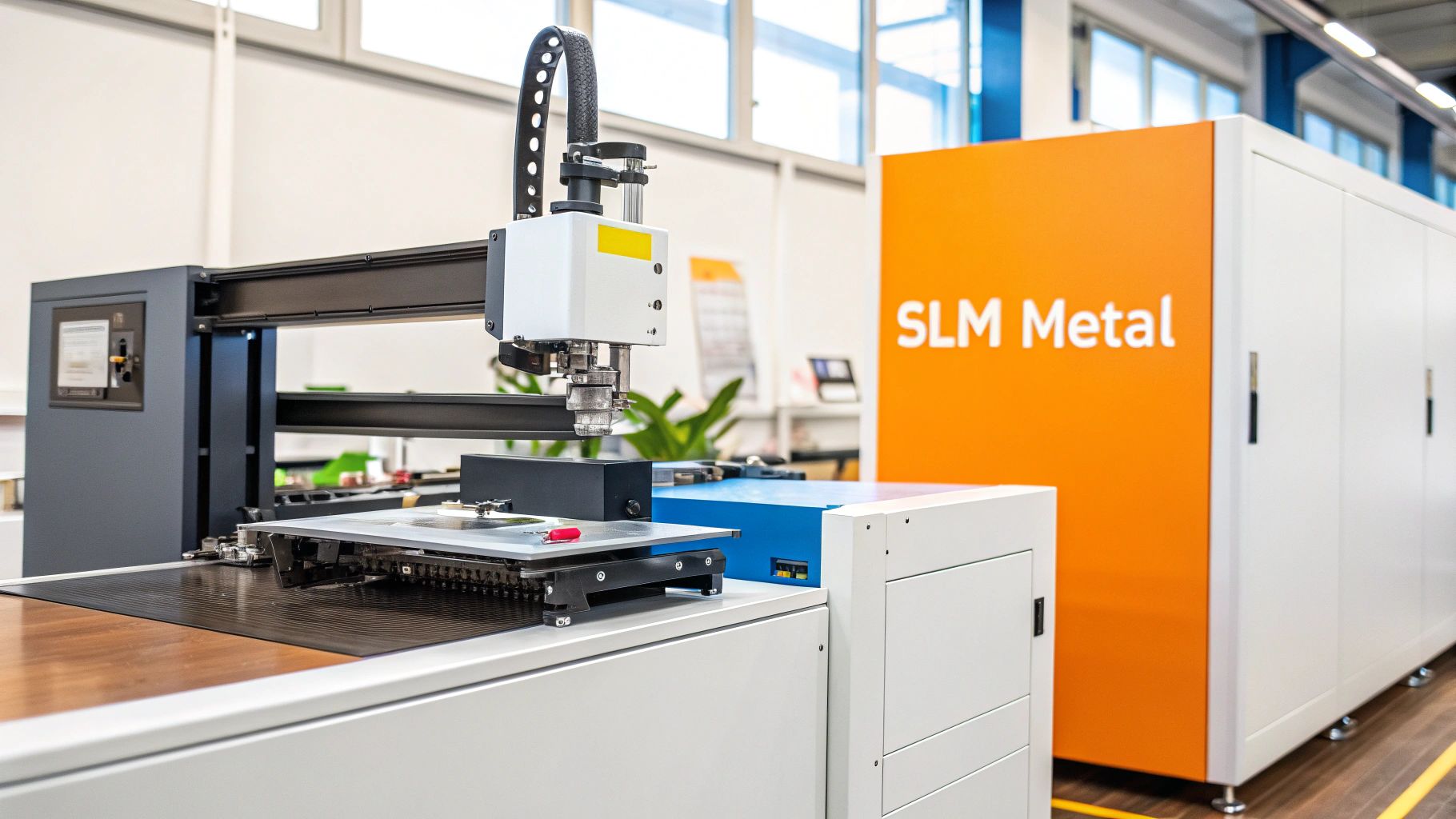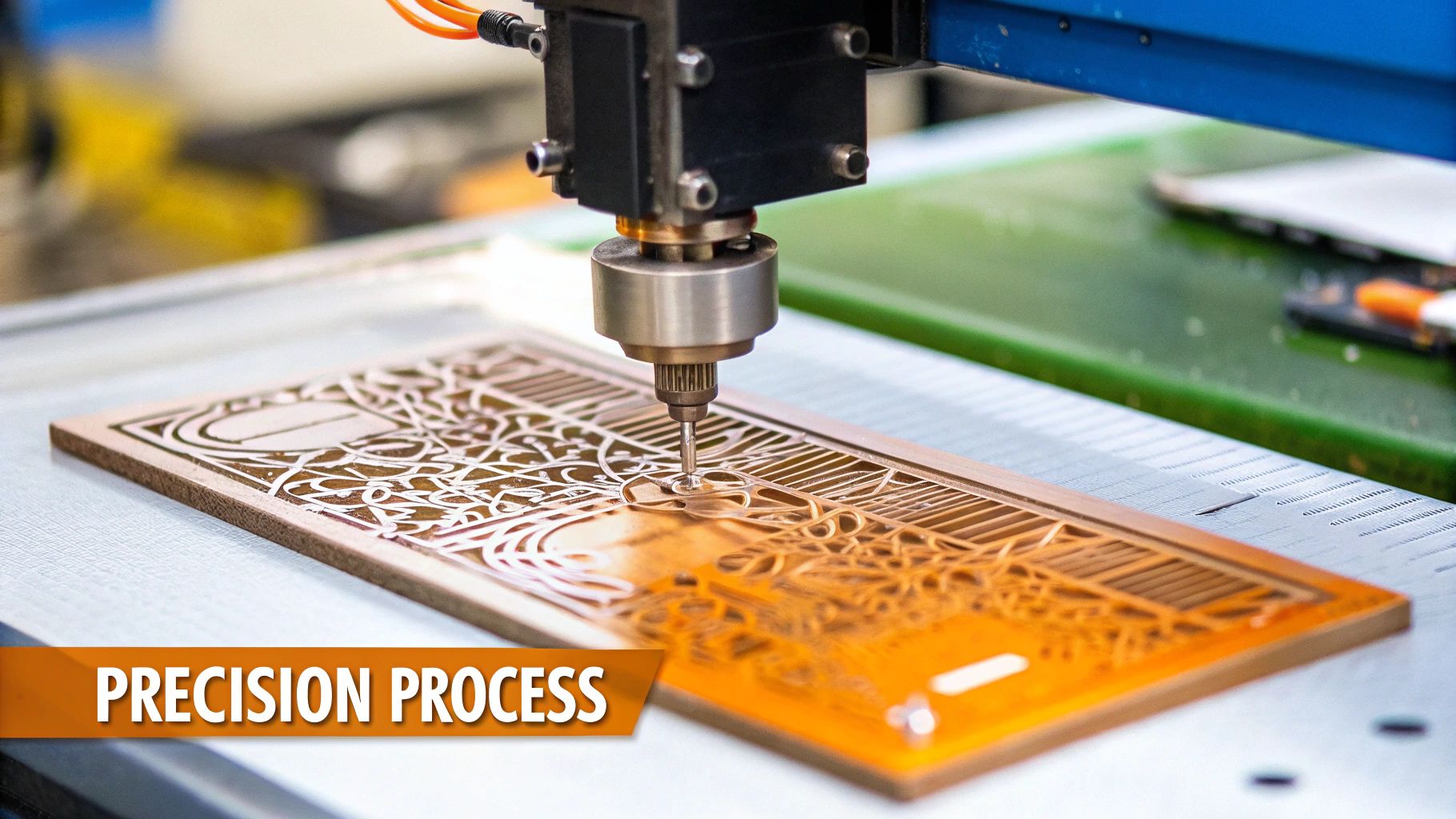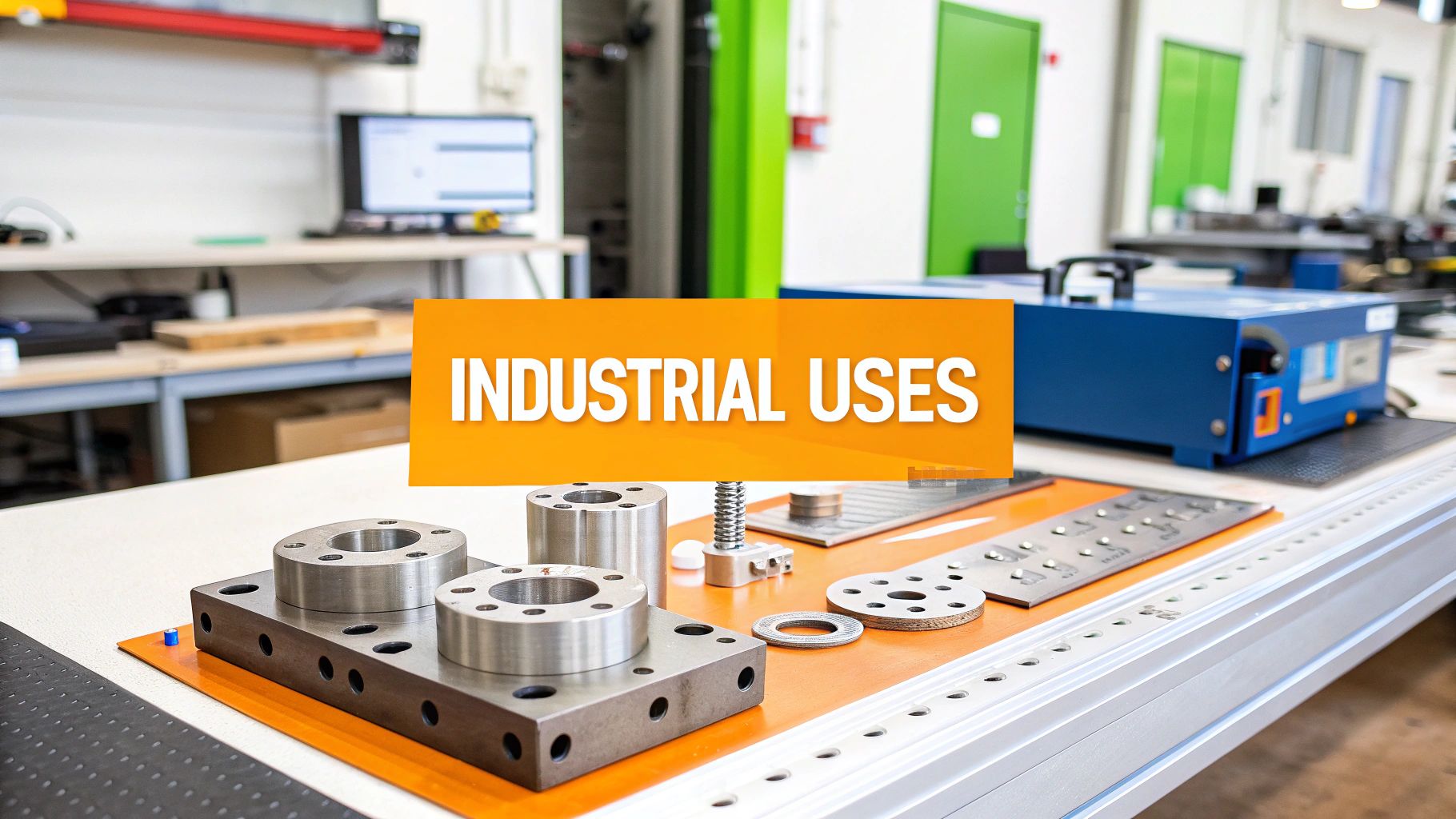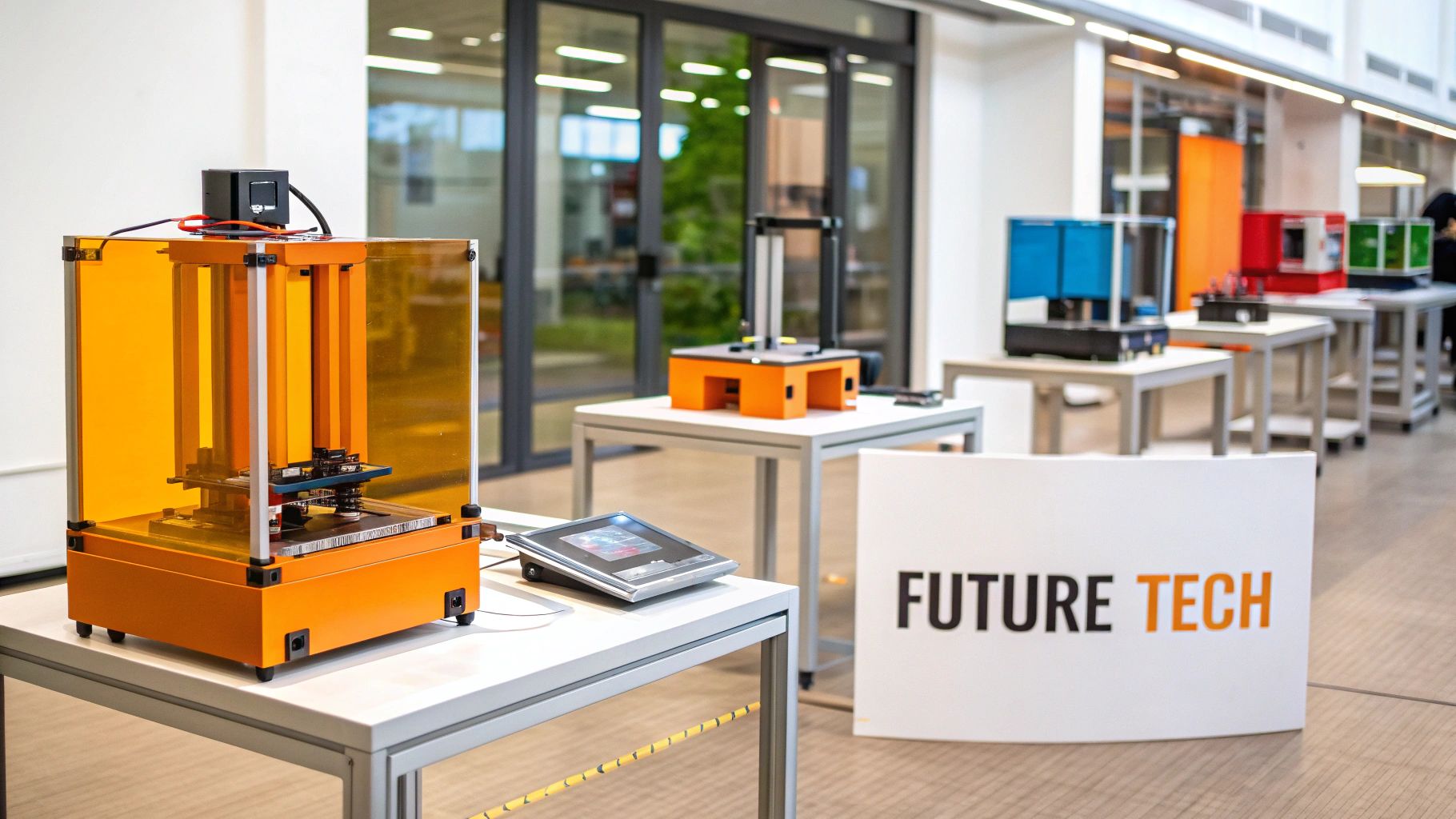The Power Behind SLM Metal Printing Technology

Selective Laser Melting (SLM), also known as SLM metal printing, represents a significant leap forward in additive manufacturing. This technology uses a high-powered laser to melt and fuse powdered metal, layer by layer. This allows for the creation of 3D objects directly from a digital design.
This process unlocks the potential for highly complex geometries and intricate internal structures impossible to create with traditional manufacturing. It opens doors to innovative designs and performance enhancements across various applications.
Understanding the SLM Process
The SLM process requires a precisely controlled environment. Inside a build chamber filled with inert gas, a powerful laser beam melts metal powder according to the design specifications. A sophisticated scanning system guides the laser's precise movements, ensuring accurate and consistent results.
As each layer solidifies, the build platform lowers, and a fresh layer of powder is distributed. This process repeats until the object is complete.
Key Advantages of SLM Metal Printing
-
Complex Geometries: SLM excels at creating parts with intricate internal channels, lattice structures, and complex external shapes.
-
High Precision: The focused laser beam allows for fine details and tight tolerances, producing high-quality parts.
-
Material Variety: SLM is compatible with various metal powders, including titanium, aluminum, stainless steel, and nickel-based superalloys. This versatility makes it applicable across diverse industries.
-
Excellent Mechanical Properties: Parts created through SLM demonstrate impressive strength, density, and durability, often matching or exceeding traditionally manufactured components.
This ability to create such high-quality components is driving SLM's growing market share. In 2023, SLM technology held a 5.36% share of the total global metal 3D printing market revenue. Its popularity comes from the ability to build complex metal parts directly from powders. Industries like aerospace, automotive, and healthcare are increasingly adopting SLM for prototypes, tooling, and production of lightweight, high-strength parts, further expanding the market. More detailed statistics can be found here: Grand View Research
SLM vs. Other Metal 3D Printing Technologies
SLM shares similarities with other metal additive manufacturing processes like Direct Metal Laser Sintering (DMLS) and Electron Beam Melting (EBM), but key differences exist. DMLS typically sinters, or partially melts, the metal powder, creating slightly porous parts.
EBM uses an electron beam within a vacuum chamber. This makes it well-suited for reactive metals but requires different approaches to material properties and post-processing. SLM, by fully melting the powder, creates denser parts with superior mechanical properties, making it a preferred choice for demanding applications.
These distinctions affect material choices and design decisions. Understanding the strengths and limitations of each technology is crucial.
Mastering SLM Process Parameters for Exceptional Results
Building on the basics of Selective Laser Melting (SLM) metal printing, let's explore the critical area of parameter optimization. This is the key to transforming good parts into truly exceptional components. Understanding the interplay between laser power, scan strategies, and powder characteristics is paramount for achieving the stringent quality standards required by demanding industries like aerospace.
The Impact of Laser Power
Laser power sits at the heart of the SLM process. It dictates how effectively the metal powder melts and fuses, having a direct impact on the final part's density and mechanical properties. Insufficient power can lead to incomplete melting and porosity, weakening the part. Conversely, excessive power can cause unwanted vaporization and detrimental material changes. Finding the "Goldilocks" setting—not too much, not too little—is crucial for achieving optimal results. For further insights into laser parameters, check out this resource: How to master laser parameters
The quality and efficiency of SLM-produced parts are heavily influenced by several key process parameters. Laser power, in particular, is fundamental to achieving complete melting and maximizing the density of the metal powder. Studies have shown that correctly calibrated laser power settings can yield parts with a relative density exceeding 99.5%. This rivals, and sometimes even surpasses, the density of traditionally forged parts. This high density is attainable because sufficient laser energy guarantees the complete melting of powder particles, fostering excellent fusion and minimizing defects like porosity. Commonly used lasers in SLM systems include solid-state lasers like YAG and fiber lasers, and occasionally, CO2 lasers, chosen for their specific wavelength and power stability. Delve deeper into the role of laser power in SLM with this research: Laser Power Research. Precisely adjusting parameters like laser power, scan speed, and layer thickness directly influences the final part's mechanical properties and surface finish.
Scan Strategies and Their Significance
Beyond laser power, the path the laser takes across the powder bed—the scan strategy—plays a significant role. Different strategies, such as hatching, contouring, and island scanning, influence how the material melts and solidifies. The chosen strategy impacts residual stress, potential part distortion, and the overall build time. For instance, a hatching strategy may be ideal for large, flat surfaces, while contour scanning can enhance the surface finish of complex curves.
Powder Characteristics: A Critical Factor
The properties of the metal powder itself are just as crucial to SLM success. Factors like particle size distribution, flowability, and oxygen content influence the powder's behavior throughout the process. Consistent particle size promotes uniform melting and predictable results. Good flowability ensures even powder distribution across the build platform, which is essential for consistent layer formation. Maintaining low oxygen content prevents oxidation, preserving material integrity. These factors are especially important when processing reactive metals like titanium.
Material-Specific Parameter Optimization
Different metals demand tailored SLM parameter settings. Titanium, known for its high melting point and reactivity, requires precise control over laser power and scan speed to mitigate oxidation and ensure proper fusion. Aluminum, with its high reflectivity and thermal conductivity, necessitates adjustments to compensate for energy loss and rapid heat dissipation. While less reactive than titanium, stainless steel presents challenges related to thermal stress and potential warping. Understanding these material-specific nuances is essential for successful SLM metal printing. Each material has its own set of considerations that ultimately affect the quality of the final part.
To summarize the key SLM process parameters and their impact, let's look at the following table:
Key SLM Process Parameters and Their Effects This table summarizes the critical parameters in SLM metal printing and how they impact part quality and performance.
| Parameter | Typical Range | Primary Effect | Secondary Effects | Optimization Tips |
|---|---|---|---|---|
| Laser Power | 100-500 W | Melt pool size and depth | Porosity, surface roughness, residual stress | Adjust based on material and desired density |
| Scan Speed | 500-2000 mm/s | Build rate, melt pool shape | Surface roughness, residual stress | Balance speed with desired quality |
| Layer Thickness | 20-100 µm | Resolution, build time | Surface roughness, part strength | Optimize for desired feature detail and build time |
| Hatch Spacing | 50-200 µm | Density, melt pool overlap | Surface roughness, residual stress | Adjust based on material and laser power |
| Powder Particle Size | 15-45 µm | Flowability, packing density | Porosity, surface roughness | Choose size appropriate for material and desired resolution |
| Oxygen Content | < 0.1% | Material properties | Porosity, mechanical strength | Minimize oxygen to prevent oxidation |
This table highlights the intricate relationships between SLM parameters and their effects on part quality. Careful optimization of these parameters is crucial for achieving desired outcomes.
Strategic Material Selection for SLM Metal Printing Success

Material selection plays a crucial role in the success of SLM metal printing. This section delves into the diverse range of metal powders used in SLM processes across various industries. We'll explore how the properties of these materials translate into real-world performance, from the titanium alloys used in aerospace to the biocompatible cobalt-chrome employed in medical implants.
Understanding Key Powder Characteristics
The success of a Selective Laser Melting (SLM) build often depends on the characteristics of the metal powder used. Three key characteristics are particle size distribution, flowability, and oxygen content.
A consistent particle size distribution is essential for uniform melting and predictable results. Good flowability ensures even powder distribution across the build platform, crucial for consistent layer formation. Think of pouring fine sand versus gravel – the consistent grains of sand create a smoother, more level surface.
Low oxygen content is vital to prevent oxidation and maintain the material's integrity.
Material Properties and Real-World Performance
Different materials possess unique properties that make them suitable for specific applications. Titanium alloys, known for their high strength-to-weight ratio and corrosion resistance, are frequently used in aerospace applications.
Medical implants, on the other hand, often require biocompatible materials like cobalt-chrome alloys. The intended use of the final product significantly influences material selection.
The selection process must consider the specific demands of each project. Factors such as required strength, weight, and the operating environment all play a crucial role, rather than simply relying on general recommendations.
Material Selection Based on Industry Application
The aerospace industry often requires materials that perform exceptionally well under stress. Titanium alloys, with their high strength and light weight, are a natural choice. The LEAP engine, a collaboration between GE Aviation and Safran Aircraft Engines, features 3D-printed fuel nozzles made from titanium alloys. These nozzles are 15% lighter and five times more durable than traditionally manufactured parts.
The medical field relies heavily on biocompatible materials for implants. Cobalt-chrome alloys fulfill these biocompatibility requirements while also offering excellent wear resistance. This makes them suitable for hip and knee replacements.
Emerging Materials and Future Capabilities
The field of SLM metal printing is constantly evolving, with new materials continuously being developed. Researchers and manufacturers are exploring new alloys and composites specifically designed for SLM processes.
These advancements expand the possibilities of SLM. For example, new high-strength aluminum alloys are being developed for applications requiring lightweight yet strong components.
This ongoing development keeps SLM at the forefront of advanced manufacturing. The continuous innovation in material science promises to unlock even greater capabilities, further broadening the applications of SLM metal printing.
Transforming Industries Through SLM Metal Printing

Selective Laser Melting (SLM) metal printing is reshaping how companies design and manufacture products. This additive manufacturing process offers new possibilities, impacting industries from aerospace to healthcare. This section explores SLM's expanding market, its application across various sectors, and the advancements driving its wider adoption.
SLM's Impact on Key Industries
SLM is proving invaluable across diverse industries. In the aerospace sector, SLM allows for significant weight reductions in aircraft components, leading to fuel efficiency gains. Medical device manufacturers leverage SLM to produce customized implants, improving patient care. The automotive industry utilizes SLM to create complex, high-performance parts with optimized designs.
These applications demonstrate SLM's adaptability and potential to revolutionize manufacturing. For more information on laser technologies, explore this resource: More on laser technologies
Market Growth and Regional Trends
The global market for SLM metal printing is experiencing remarkable growth. Valued at approximately USD 13.3 billion in 2025, the market for SLM 3D printers is expected to continue expanding. This growth is fueled by the rising demand for precise, lightweight, and complex metal parts, particularly within the aerospace and medical sectors.
North America currently leads the SLM market due to its established ecosystem of manufacturers and end-users. However, the Asia-Pacific region is exhibiting rapid growth, indicating increasing adoption. This global expansion underscores the widespread recognition of SLM's transformative capabilities. For more market statistics, see this report: SLM Market Report
Multi-Laser Systems: A Game Changer
The advent of multi-laser systems has been crucial to SLM's growing popularity. Some systems utilize up to six lasers, substantially increasing print speed and precision. This advancement addresses the historic limitation of slow build times, a previous concern with SLM technology.
This enhanced efficiency enables higher-volume production, broadening the range of viable SLM applications. Parts that once required days to produce can now be completed in hours, significantly impacting production timelines and costs.
Driving Forces Behind SLM Adoption
Several factors are propelling businesses to adopt SLM. The need for more resilient supply chains is encouraging localized production, a capability enabled by SLM. Sustainability is another driver, as SLM reduces material waste compared to traditional subtractive manufacturing. Finally, the demand for manufacturing agility and responsiveness to market changes makes adaptable solutions like SLM highly attractive.
The following table summarizes SLM adoption across different industry sectors:
SLM Adoption Across Industry Sectors: This table compares SLM metal printing adoption, applications, and benefits across major industry sectors.
| Industry | Adoption Level | Key Applications | Primary Benefits | Notable Challenges |
|---|---|---|---|---|
| Aerospace | High | Lightweight components, complex engine parts | Reduced weight, improved fuel efficiency, design freedom | Cost of materials, qualification standards |
| Medical | Moderate | Patient-specific implants, surgical instruments | Customized designs, biocompatibility, sterilization | Regulatory approvals, material selection |
| Automotive | Growing | Complex parts, tooling | Design optimization, performance enhancement, rapid prototyping | Production scalability, material costs |
| Energy | Moderate | Turbine blades, fuel nozzles | Improved durability, high-temperature resistance | Material properties, complex geometries |
This table highlights the varying levels of SLM adoption and the unique benefits and challenges within each sector. While aerospace has seen significant integration, other industries are rapidly catching up, drawn by SLM's potential to optimize design and enhance performance. As industries continue to pursue efficient and innovative manufacturing solutions, SLM is poised to play an increasingly vital role.
Designing for SLM Success: Beyond Traditional Thinking

To truly unlock the potential of Selective Laser Melting (SLM) metal printing, we need to rethink our approach to design. Design for Additive Manufacturing (DfAM) principles open doors to possibilities that traditional methods simply can't match. This involves understanding minimum feature sizing, strategically placing support structures, and finding the optimal part orientation for the highest quality prints. For a deeper dive, check out this resource: How to master SLM design.
Minimum Feature Sizing and Detail Resolution
SLM offers incredible detail resolution, but designers must consider minimum feature sizes. This means paying close attention to wall thickness, hole diameters, and the overall design complexity. Ignoring these limitations can lead to defects during the manufacturing process.
For example, thin walls may not solidify correctly, and small holes could become blocked with unmelted powder. The key lies in finding the sweet spot between intricate design and practical manufacturability. This ensures the final product looks great and performs as expected.
Strategic Support Structures: Essential for Success
Support structures are often crucial in SLM. They anchor the part to the build platform, preventing warping or collapse during printing. However, they require careful planning.
Too many supports can be difficult to remove and might leave unwanted marks. Too few, and the part could fail. DfAM promotes strategic support placement, using as few as possible while maintaining the part's integrity. This streamlines both the build and post-processing stages.
Part Orientation: A Critical Decision
How a part is positioned in the build chamber significantly affects its quality and the efficiency of the SLM process. Different orientations can improve surface finish, reduce support needs, and boost mechanical properties.
A vertical orientation, for instance, might produce a smoother surface than a horizontal one. It can also minimize support requirements, simplifying post-processing. Therefore, exploring different orientations before printing is essential for achieving the desired outcome. This foresight can save considerable time and resources.
Topology Optimization: Lighter and Stronger Parts
Topology optimization, a valuable DfAM tool, enables the creation of lighter, stronger parts compared to traditionally manufactured components. This computational technique analyzes stress and strain distribution, removing unnecessary material while reinforcing key areas.
The result is organically shaped, material-efficient components. Think of a bridge designed to handle maximum load with minimum material. Topology optimization achieves this by strategically distributing material where it's most effective, significantly improving performance.
Real-World Applications of DfAM in SLM
DfAM principles are revolutionizing various industries. In aerospace, it enables the creation of lightweight brackets and intricate engine components. In the medical field, patient-specific implants with complex internal lattices can be designed for optimal bone integration. These examples showcase the practical impact of DfAM in SLM workflows.
Furthermore, consolidated assemblies, intricate internal channels, and advanced lattice structures are now possible, pushing the boundaries of what traditional manufacturing can achieve.
Specialized Software for SLM Workflows
Several software tools support DfAM in SLM. These tools streamline design, simulate builds, and prepare files for printing. They offer features like automatic support generation, part orientation analysis, and topology optimization algorithms.
By using these specialized tools, engineers can refine designs for manufacturability before printing, saving valuable time and resources. This predictive capability allows for iterative design improvements, leading to better part performance and printability.
Beyond the Build: Perfecting SLM Parts for Production
The completion of an SLM build is just the first step. It marks the beginning of a crucial refinement process. This section explores the essential post-processing operations that transform 3D-printed parts into production-ready components. We'll examine support removal, heat treatment, and surface finishing, and how these processes influence the final part performance.
Support Removal and Its Impact
Support structures are vital during the SLM build process. They prevent warping and maintain stability during printing. However, their removal requires careful attention. Improper removal can introduce stresses and even damage the part.
Several techniques are available for support removal:
- Wire EDM: Offers precise removal in complex areas. Wire EDM is particularly effective for intricate geometries.
- Manual Cutting: Suitable for simpler geometries and offers a cost-effective approach.
- Chemical Dissolution: Dissolves support material using specialized chemicals.
The best method depends on the material, part complexity, and the desired surface finish.
Heat Treatment: Enhancing Material Properties
Heat treatment is essential for optimizing material properties after SLM metal printing. It relieves stresses from the build process, refines the microstructure, and enhances mechanical characteristics.
Several heat treatment processes are commonly used:
- Stress Relieving: Reduces residual stresses without significantly changing hardness.
- Annealing: Softens the material, improving ductility and machinability.
- Hardening: Increases strength and wear resistance for demanding applications.
The specific heat treatment depends on the material and desired final properties.
Surface Finishing: Achieving Desired Aesthetics and Functionality
Surface finishing improves the part's functionality and aesthetics. SLM parts often have a rough surface texture immediately after printing. Surface finishing addresses this, enhancing appearance, smoothness, and other characteristics.
Common surface finishing techniques include:
- Bead Blasting: Creates a uniform matte finish.
- Machining: Achieves precise dimensions and smooth surfaces. Machining can further refine SLM-produced parts.
- Polishing: Enhances reflectivity and smoothness, particularly important for parts with strict aesthetic requirements.
Integrating Precision Machining
Sometimes SLM parts require features or tolerances beyond the printing process alone. Precision machining fills this gap, creating fine details, refining dimensions, and improving surface characteristics.
Combining subtractive processes like machining with additive processes like SLM offers significant advantages. It leverages SLM's ability to produce complex geometries and then utilizes machining for optimal precision.
Quality Assurance: Ensuring Part Integrity
Quality control is crucial throughout the entire SLM process, especially post-build. Dimensional verification confirms adherence to design specifications. Advanced CT scanning detects internal flaws invisible to the naked eye. Metallurgical analysis assesses the material's composition and structure. These processes ensure part integrity and consistent performance.
Qualification Procedures and Traceability
Robust qualification procedures tailored to specific industry requirements are vital. Statistical process controls help identify and correct process variations. Maintaining detailed traceability systems, especially in regulated industries like aerospace and medical, is essential for quality and compliance. These systems document the part's entire journey, from powder selection to final inspection, ensuring accountability and demonstrating regulatory compliance.
Ready to explore the possibilities of SLM metal printing? Learn more about laser technologies, including SLM, at https://laser-podcast.com.

